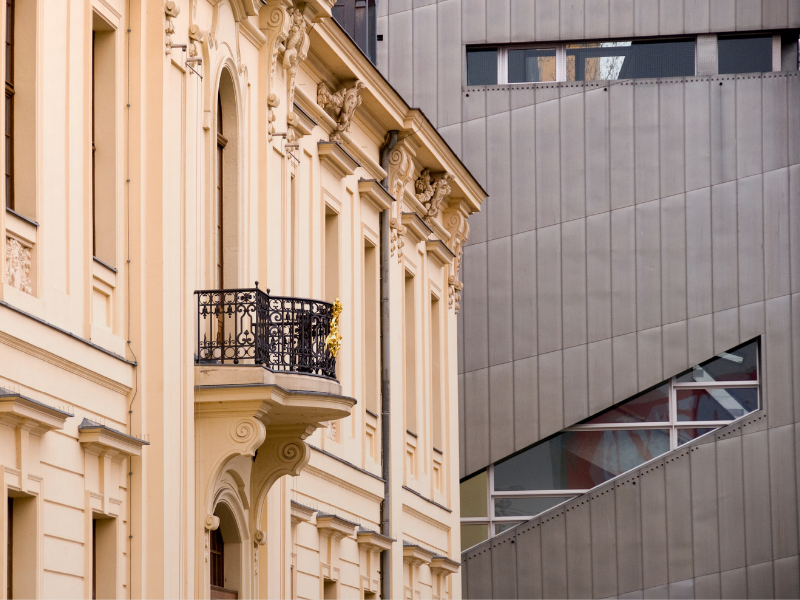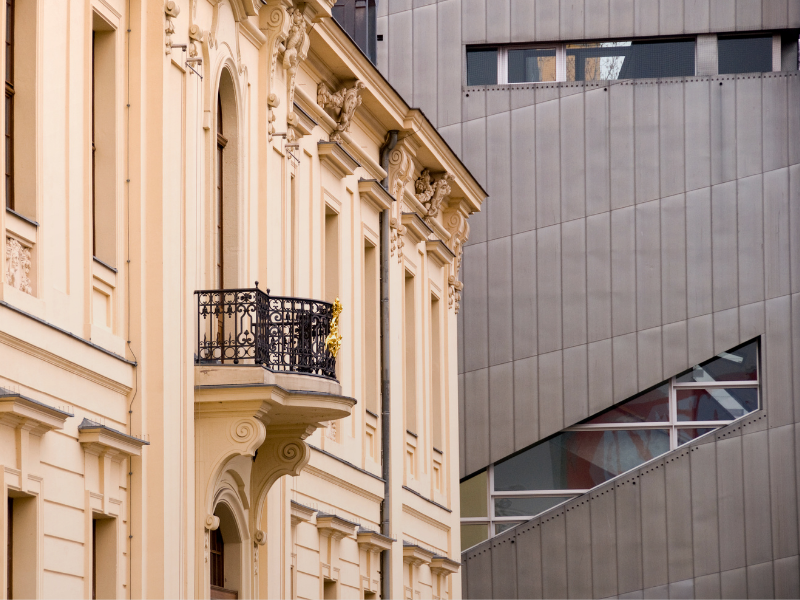The Jewish Museum Berlin is one of Europe’s most important cultural institutions, which offers a deep and emotional examination of Jewish history, culture and heritage.
Situated in the heart of Berlin, the museum’s eye-catching architecture and extensive displays create an immersive visit that reflects the breadth and variety of Jewish life.
Historical Background
Origins and Founding
The idea for the Jewish Museum Berlin was born in the late 1970s and it opened to the public in 2001.
Its purpose is to preserve, study and exhibit the history of Jews in Germany from the Middle Ages until today, standing as a testament to their resilience over centuries of persecution.
Architectural Importance
Designed by world-renowned architect Daniel Libeskind, it is a stunning architectural masterpiece that combines contemporary design with deep symbolic meaning. Libeskind called his design “Between The Lines,” signifying Jews’ complex relationship with Germany throughout history.
The jaggedness and emptiness within this structure represent how fractured German-Jewish relations have been historically — especially during World War II when many Jewish lives were lost or destroyed within these walls. A zinc-coated exterior helps give off an eerie reflection while also making you feel disoriented.
Design Features
Exterior Design
The outside appearance consists mainly on irregular windows alongside its fascinating zinc-plated frontage which is recognized for being exceptional among other buildings around its location because they don’t conform to any standard shape or size thus creating more drama through this asymmetrical arrangement representing troubles faced by Jews within Germany over time . Traditional architectural standards are challenged by such designs inviting people to think about issues like displacement ,memory loss etcetera .
Void Spaces
One unique aspect about this place that leaves everyone speechless are these empty spaces running across the structure which remind us all how much jewish life was lost during holocaust hence could not be filled again .
The emptiness is intentional, and they are meant to stay that way so as to act as powerful reminders of what can never be replaced in our hearts or minds .
Garden of Exile
This outdoor installation serves as a disorienting reminder for those who lived through it and an educational experience for younger generations. It consists 49 tall concrete pillars arranged in grid pattern on sloping ground ,with each having olive trees growing from its top signifying hope rejuvenation after every storm .
The garden acts physical mirror to Jews who were forced flee their homes during world war two where it’s designed make them feel like everything around has changed place thus making difficult finding orientation once again.

Holocaust Tower
The Holocaust tower is another stunning feature at the Jewish Museum Berlin which seeks to provide visitors with feeling isolated helpless while inside there.It’s outer walls are made up entirely out concrete but have small slit towards top that allows thin beam light penetrate darkness inside space.
You usually describe this area as one most silent parts within museum because even though many people may be walking around outside nobody can hear anything coming from within due thick walls surrounding entire building itself .
The Enlightenment and Freedom
This part examines the age of enlightenment and then the emancipation of Jews in Germany. It emphasizes major figures like Moses Mendelssohn, and discusses what challenges and opportunities that Jewish communities had during this time.
Jewish Life between the 19th and 20th Centuries
This exhibition digs into social cultural as well as economic life among German Jews in the long nineteenth century through World War I. It has objects such as artifacts, photos, personal stories which reflect different experiences that were had by Jews at this period.
The Holocaust
With testimonies, photographs and objects from victims themselves; this exhibit presents an emotional account about how systematically Jews were persecuted until they were all gone during WW2 – Holocaust.
Postwar & Contemporary Jewish Life
After WWII there was a renaissance for Jewish people living in Germany again but this time around it also covers post war era up until now when we talk about rebirth/resurgence.
Here they recognize contributions made by those who came after them within wider society while still striving to keep their heritage alive because it is important not forget where you come from.
Exhibitions on a Temporary Basis
Another thing that can be seen in the Jewish Museum Berlin are temporary exhibits. These displays usually focus on specific events or areas of Jewish history and culture and change regularly to give visitors different perspectives about what they have seen.
Multi-Media Displays and Interaction
In order to make visiting more interesting, the museum has included different multi-media displays. There are touch screens, audio guides, and video installations which help people understand exhibitions better by providing background information about them. Such use of technology allows individuals not just to learn things but also get involved into this process actively.
Visitor’s Tips
Location and Ways to Get There
Situated at Lindenstraße 9-14 in Kreuzberg district, the Jewish Museum Berlin is easy reachable using public transport:
Take subway: U1 or U6 (Hallesches Tor) – nearest underground station from museum entrance is few minutes walk away;
Several buses stop close to the building too – e.g., line M29 or 248 among others.
Working Hours
The museum works every day with extended hours on weekends/holidays (from 10 a.m till 8 p.m); however times may vary so it is recommended checking official site for updates.
Guided Tours & Audio Guides
For deeper insight into displayed items it is worth taking guided tours which provide detailed explanations given by knowledgeable guides who know all about exhibits’ history etc.; another option – audio guides in different languages allowing visitors learning more while scanning through halls at their own pace.
Crowd Avoidance Strategy
For those wishing less crowded experience try coming early morning or late afternoon when there aren’t many people around yet; weekdays tend to be less busy than weekends anyway.
Map
Surrounding Sights
Checkpoint Charlie
Being not far away from Jewish Museum Berlin, Checkpoint Charlie represents one of most well-known border crossings during Cold War times. The place includes museum telling about history of Berlin Wall and stories behind its attempts to be crossed by people; thus it serves as reminder how city was divided in past and remains important historical spot for visitors.
Berlinische Galerie
Another interesting attraction close nearby is the Berlinische Galerie which ranks high among capital’s modern art, photography & architecture museums. It showcases wide range works made by artists based mainly in Berlin therefore giving insight into lively artistic environment here.
Topography of Terror
Situated on site where former Gestapo HQs used to stand, Topography of Terror is both outdoor/indoor museum providing comprehensive overview on Nazi regime with all its crimes against humanity etc.; must-see for those looking deeper into German history during WWII.




